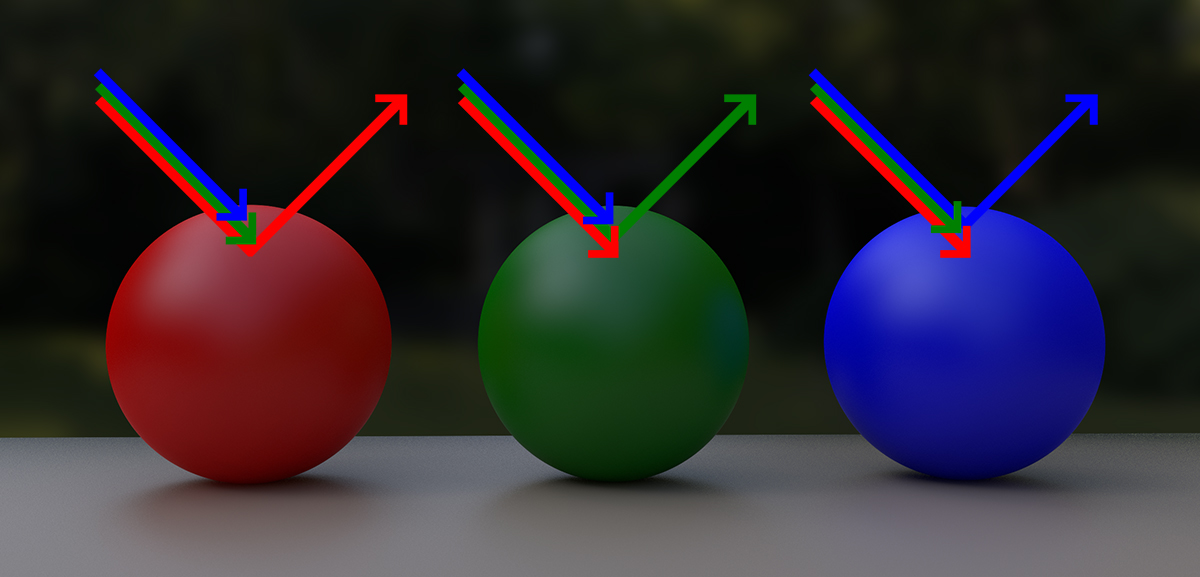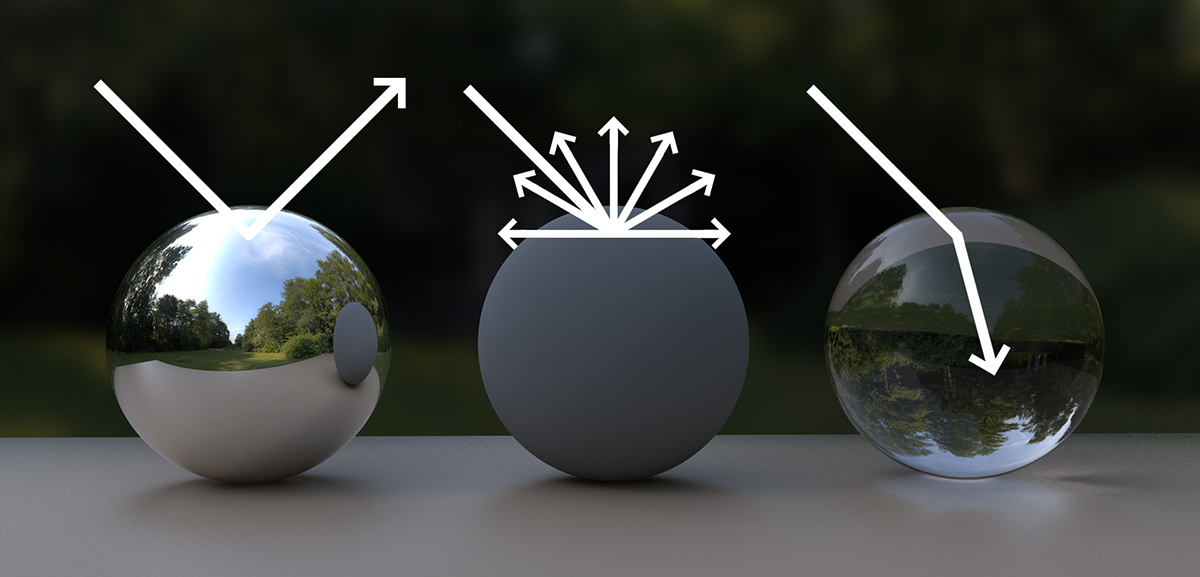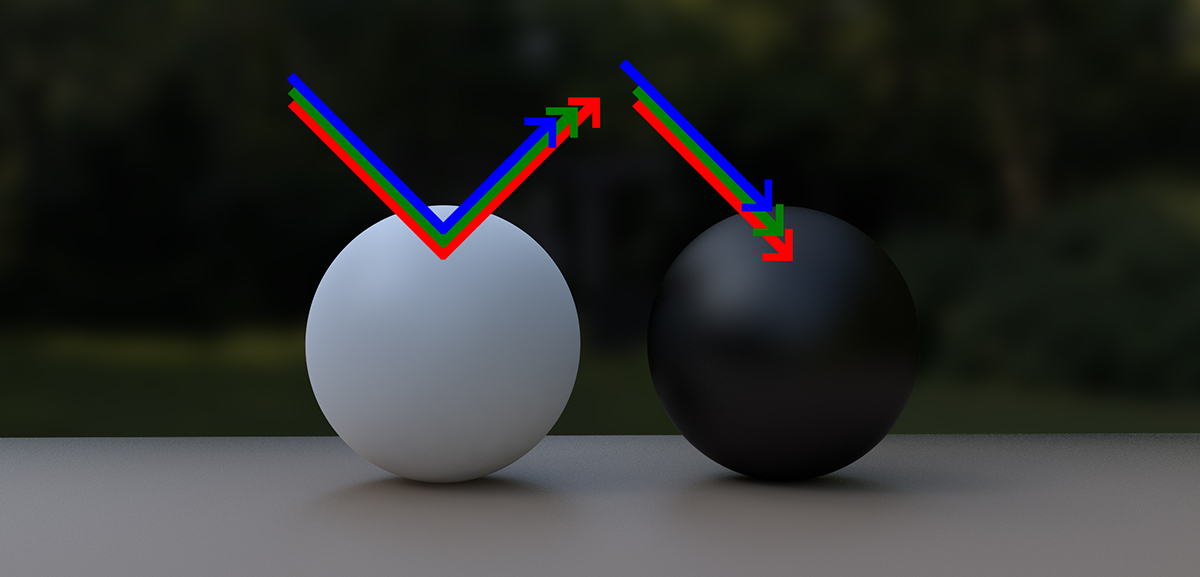Search the wiki
Introduction to Light and Matter
Introduction
In recent years there has been there has been a movement towards Physically Based Rendering (PBR), where lighting setups and materials mimic real-life light situations. Both realistic and cartoony work require believable lighting, so it is very much in your interests to get an appreciation of how light behaves in the real world.
Before we begin, I want you to remember that although there have been vast improvements in techniques and processing speeds to simulate light and matter in the digital world, you need to be aware that everything in the computer is just that – a simulation.
For demonstration purposes, I’ll be using the CAVE Maya Material Development Light Rig 1003.
What is Light?
So what is light exactly? Essentially, light is a type of wave; one that is composed of electric and magnetic fields. Hence it is referred to as electromagnetic radiation (EMR). From the electromagnetic spectrum, which consists of radio, microwave, infrared, ultraviolet, x- ray and gamma rays, the human eye is only able to see a small portion of this spectrum, which we call light. As light is emitted, small packets of energy called photons are produced, and it is these photons that allow us to view the world around us.
Law of Reflection
Our next stop is to take you back to your physics classroom and reacquaint you with the phenomena of reflection.
In reflection, when light rays hit a smooth surface such as a mirror, they bounce off at an angle equal to the angle at which the rays hit the surface. This is known as the Law of Reflection, as described by the Ancient Greek mathematician Euclid in 300 BCE.
Image from: https://commons.wikimedia.org
When it comes to the Law of Reflection, we need to be aware of the following:
- i = Incident Ray. This is the light ray approaching the surface (for example, the light hitting a mirror).
- r = Reflected Ray. This is the light ray reflecting off the surface (for example, bouncing off a mirror).
- N = Normal Line. This is an imaginary line running perpendicular to the surface of an object at the point where the light ray makes contact. This Normal Line will break up the angle between the incident ray (i) and reflected ray (r). This results in…
- Θi = Angle of incidence. This is the angle between the indident ray and the Normal Line. Pronounced ‘Theta i’.
- Θr = Angle of reflectance. This is the angle between the reflected ray and the Normal Line. Pronounced ‘Theta r’.
The Law of Reflection (as referenced from this Wikipedia page), states the following:
If the reflecting surface is very smooth, the reflection of light that occurs is called specular or regular reflection. The laws of reflection are as follows:
- The incident ray, the reflected ray and the normal to the reflection surface at the point of the incidence lie in the same plane.
- The angle which the incident ray makes with the normal is equal to the angle which the reflected ray makes to the same normal. Θi = Θr
- The reflected ray and the incident ray are on the opposite sides of the normal.
These three laws can all be derived from the Fresnel equations.
Specular and Diffuse Reflection
Reflection is reflection. But we tend to describe reflections as being Specular or Diffuse. The topic gets a little deep when we take into consideration the type of material that light is bouncing off, i.e. conductors and insulators. So, we will bounce back to that topic at a later stage. For now, we’ll keep things simple by referring to an object as ‘smooth’ or ‘rough’.
On a very shiny object, like a mirror, you’d see very clear reflections. This is because the surface is very smooth and we commonly refer to this result as specular reflections.
However, the majority of surfaces are not smooth but are in fact rough, especially on a microscopic level. When light rays hit a rough surface, they bounce off at multiple angles. This brings up to the concept of diffuse reflection.
Let’s first focus on specular reflections. If you visualise parallel light rays hitting a smooth surface (like a mirror), each of these rays of light will reflect equal to the incoming ray. This is due to the surface of the object, on a microscopic level, being very smooth.
In this example, I’ve created a mirror like material (silver or aluminium) and I’ve set the value for the Base Colour to 0.9 (to match the reflectivity value of the material). I’ve also set the Metalness value to 1, and lastly, I’ve applied the same value of 0.9 to the Specular Colour. Next, scrub the Specular Roughness value between 0 and 1 to see the results. At 0, you’ll see clear reflections, and at 1, they’ll be very rough.
Now take an object that is a little rougher (for example, concrete or wood). On a microscopic level, the surface of the object is irregular, and therefore, that same beam of parallel light is scattered and spread about as it reflects off the surface.
Please note that the Law of Reflection is true for both specular and diffuse reflection. The difference between specular and diffuse reflection is the orientation of the Normal Line due to the roughness of the object. This results in the Normal Lines for adjacent light rays not being parallel with its neighbouring light rays.
Before we move on, I’d like to mention the how I go about adding surface imperfections to an object. So far, we’ve been using the Roughness parameter on the shader to add surface irregularities on a microscopic level. Another way to break up the surface of a mesh during rendering is to use a Bump, Normal or Displacement map (or a combination of these maps). I actually prefer to add a Displacement and Normal map first before playing with the Roughness map, as I find this sometimes does the majority of what I’m looking for when it comes to reflections.
Refraction
Refraction occurs when light rays pass from one transparent medium to another, for example when light crosses the boundary from air to water. As this happens, the speed of the light changes and the ray bends either towards or away from the Normal Line. Snell’s law describes the degree to which the light bends, which is known as the angle of refraction, and its size depends on the degree to which the object has slowed the light rays down.
Image from: https://commons.wikimedia.org
As illustrated in the image below, as the light travels between the air and then the glass and water (both of which are more dense), it slows down.
Image from: https://commons.wikimedia.org
In a vacuum (empty space devoid of all matter and energy fluctuations), the speed of light travels 300,000 kilometres per second; 186,000 miles per second; 671 million miles per hour! A vacuum has a refractive index of 1. As we measure the ratio of the speed of light through a denser material, we call this the refractive index of the material. So, an object with a refractive index of 2 would slow light down by half. The higher the refractive index, the more the light bends as it passes through and the more it slows down the incoming ray.
Diamonds have a high index of refraction, and sparkle so very famously by effectively trapping light. Lenses work by refracting light and can serve to improve a person’s vision by making distant objects seem nearer or vice versa.
Image from: https://commons.wikimedia.org
Colour
Staying in the physics classroom, you may remember splitting light using a prism and seeing that white light is made up of the colours of the rainbow. The fact, therefore, that the world around us does not have colour of itself, that objects simply reflect, refract or absorb colour and therefore appear colourful, is pretty mind bending.
Image from: https://commons.wikimedia.org
The colour of an object is the colour of the light it reflects: your red Ferrari parked outside is not red, it just reflects red wave lengths; the grass of your croquet lawn is green because it reflects green wave lengths. What you see is what was reflected.
Objects appear white because they reflect all colour, and conversely, objects appear black because they absorb all colour and in that absorption, heat is created.
This brings us neatly to the topic of colour temperature. Each light source, be it a candle, the sun or a headlamp, has its own individual colour, or colour temperature which varies on a scale from red (warm) to blue (cool). Colour temperature is recorded in Kelvin.
Cool colours such as blue will have a Kelvin of over 7000, while warmer colours such as orange or red will measure around 2000K. Daylight, with a Kelvin of around 5000 comes around the middle of this scale. So when you think about the physical world, remember that the hotter an object, the bluer it will be, and the cooler an object, the more red it will be.
Bill Nye the Science Guy – S01E16 Light and Color
This video by Bill Nye is a fantastic primer to get a solid understanding of light and color.
Further Reading
- The Physics Classroom – This website is simply amazing!
- Light is It a Wave or a Particle? Just what is the true nature of light? Is it a wave or perhaps a flow of extremely small particles? These questions have long puzzled scientists. Let’s travel through history as we study the matter.
- The Grey, the Chrome and the Macbeth Chart – Here is a breakdown of how we go about using the Grey ball, the Chrome ball, and the Macbeth chart for look development and lighting.
Onset Training
For more information on all things onset related, you can check out our courses here:
- Onset Data Acquisition 1001
- Introduction to Cameras and Lenses 1001
- Shooting HDRIs and Panoramas 1001
- Shooting Texture and Look Development Reference 1001
Look Development and Lighting Training
The Connection Programme
If you are a fan of mixing science with art, or maths with creative thinking, then join our Connection Programme, where we’ll be exploring VFX, animation and games from the core fundamentals:
Support CAVE Academy
Here at CAVE Academy the beauty of giving and sharing is very close to our hearts. With that spirit, we gladly provide Masterclasses, Dailies, the Wiki, and many high-quality assets free of charge. To enable the team to create and release more free content, you can support us here: Support CAVE Academy











Wonderful treatise on the properties of light!
Thanks Dr. Ron Persin.
Thanks Cave Academy for this theory ❤️. This is very helpful.
Thank you